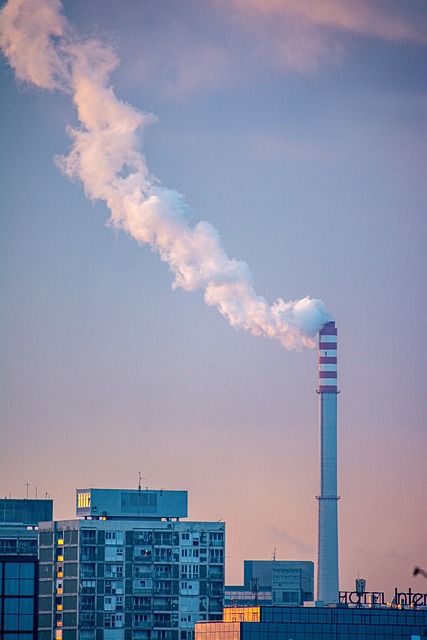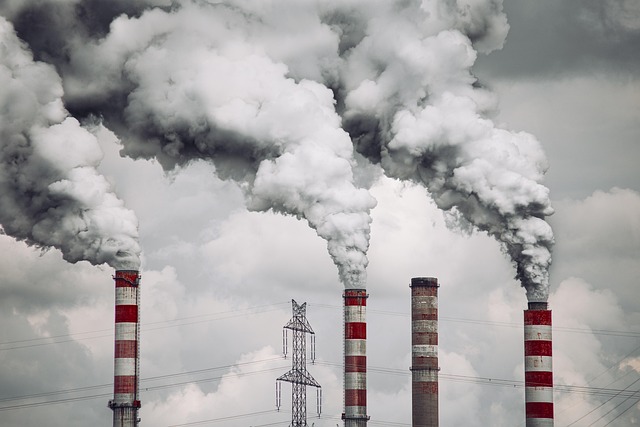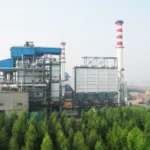Design and sizing of Boiler chimney/stack is a vital part in Thermal power plants. Chimneys are generally of steel or RCC. For smaller sized Boilers, steel chimneys are used and for bigger size power plants RCC chimneys are used.

What is the function of Chimney in Power plants or Boilers operation?
A boiler chimney (or stack) is a vital part of any steam or thermal power plant. It ensures the safe release of flue gases at a height where they disperse into the atmosphere without harming plant operators or the surrounding environment.
- To provide natural draft for combustion.
- To disperse flue gases (CO₂, SO₂, NOx, particulate matter) at safe levels.
- To protect the environment and comply with pollution control norms.
So, in order to perform above functions, the design and sizing of the Chimney is very vital part.
Calculation of the Chimney size mainly needs following inputs.
- Boiler capacity: The mass of flue gas generated
- Type of fuel (coal, oil, gas, biomass): Sulphur content in the fuel. Combustion air requirement.
- Flue gas temperature & velocity: Density factor
- Ambient temperature
- Environmental emission standards.
- Wind load & seismic considerations
- System resistances, draft loss
- Government compliances etc.
Basic construction details of RCC Chimney;
Parts of Chimney:
- Foundation
- Shaft
- Man hole doors
- Inspection doors
- Weep Holes
- Sampling holes
- Refractory lining
- Aviation lamps
- Access ladder

Foundation
Strong RCC (Reinforced Cement Concrete) base to withstand load and wind pressure.
Depth depends on soil conditions and chimney height.
Generally Raft of the RCC chimney is around 3 times the diameter of the Chimney and depth around 3 meters or equal to the size of the Chimney Internal diameter.
Chimney Lining
Protects outer shell from high heat and corrosion. Often made of acid-resistant bricks or castable refractory. There will be around 100 mm gap between RCC structure and internal refractory linings.
There will be holes provided at the periphery of the chimney through its length to ensure cooling of the concrete
Chimneys have access Provisions like Ladders, inspection platforms, lightning protection, and aviation lights.
Other provisions are weep holes for removing water or moisture. These are generally provided at the bottom of the foundation.
Sampling holes for are located at particular height for collection of flue gas samples to analyse SOx, NOx, SPM etc
In this post we shall calculate the size of the Chimney based on just sulphur content in the fuel and mass of flue gas generated.
Read more>>>>>>Questions answers & calculation on Boiler draught & Chimney
Formulae used for calculation of Chimney size
1-Chimney Height
H = 14 X Q0.3
Where, Q = Quantity of Sulphur dioxide emitted per hour from the Boiler
14 is the derived constant.
2-Chimney Internal diameter calculation
D =√ (4 X Mass of flue gas generated in m3/sec from the Boiler X Velocity of the flue gas in chimney / Π)
Let us discuss this by taking an following example
1-A Boiler of capacity 200 TPH, consumes around 35 TPH of coal, calculate the height and Internal diameter of the Chimney if flue gas temperature at chimney inlet is 140 deg C
Consider following ultimate & proximate analysis data.
% of carbon (C) in coal: 62.2%
% of Hydrogen (H2) in coal:4.5%
% of Oxygen (O2) in coal: 22%
% of Sulphur (S) in coal: 0.9%
% of Nitrogen (N2) in coal: 1.2%
Moisture: 14%
Ash: 9%
Now, based on above inputs, calculate the Theoretical air required for combustion.
Theoretical air Thair = ((11.6 X C% + (34.8 X (H2-O2/8)) + (4.35 X %S))/100
Thair = ((11.6 X 62.2 + (34.8 X (4.5-22/8)) + (4.35 X %0.9))/100
There fore Theoretical air requirement = 7.86 kg/kg of coal
Since coal has some percentage of moisture in it, so need to provide excess air to evaporate that moisture. Generally, for coal fired boilers, 20-25% of excess air is given for complete combustion of the fuel.
Therefore, total combustion air = Theoretical air + Excess air
= 7.86 + 7.86 X 25% = 9.82 kg/kg of coal.
Read more>>>>>>Calculations on fuels and combustion
As a thumb rule;
Mass of flue gas generated = Mass of combustion air + Mass of fuel burnt-Mass of ash generated
Mass of flue gas generated = 35 X 9.82 + 35-(35 X 9%) = 375.55 Tons per hour
Mass of flue gas generated = 375550 kg/hr
Let’s convert this mass flow from kg/hr to m3/sec by dividing the above value by the density of the flue gas.
Density of the flue gas at 140 deg C = 273 X 1.293 kg/m3/(273+140) =0.85 kg/m3
So, Mass of flue gas generated = 375550 kg/hr /(0.85 X 3600) = 122.72 M3/sec
Let us calculate the quantity of Sulphur dioxide (SO2) generated in combustion
Quantity of Sulphur burnt = 35000 kg/hr X 0.9% = 315 kg/hr
1 Kg of Sulphur consumes 2 Kg of air to form SO2
Read more>>>>>>How to calculate the quantity of lime stone required to reduce SO2 emission ??
Therefore, SO2 formed = 2 X 315 = 630 kg/hr.
Now, calculate the Height of the Chimney
H = 14 X (Mass of SO2)0.3
H = 14 X 630 0.3
H =96.81 meter
Therefore, height of the Chimney can be selected as 100 meter.
Now, calculate the Internal diameter of the Chimney
D =√ (4 X Mass of flue gas generated in m3/sec from the Boiler X Velocity of the flue gas in chimney / Π)
D = 4 X 122.72 M3/sec /( Π X 14)
Let us assume the velocity of flue gas in Chimney is 14 m/sec
So, chimney internal diameter = 3.34 meter
Chimney outer diameter = Chimney Internal diameter X 2 X RCC Wall thickness = 3.34 X 2 X 0.3 = 3.94 meter
Considering refractory lining & Air gap, the corrected Chimney Outer diameter will be
= Chimney Internal diameter + 2 X 0.2 M refractory brick lining + 0.1 M X 2 air gap X 2 X 2 X RCC Wall thickness (0.3 M) =3.34 + 0.4 + 0.2 + 0.6 = 4.54 meters
Mass of flue gas and Velocity of gas are very important for calculating Chimney size. Velocity of flue gas less than 10 m /sec may lead to poor flue gas dispersion and even may create back pressure.
